Remember the 1990s? An entire decade of relative peace and prosperity. Nobody was worried about the Russians anymore, and people felt rich, even if they weren’t. In the ’90s, people were ready for some fun and beauty (cue Dave Hickey). Those of us who were in our early 20s at the time were imprinted by the glossy froth of paintings by Yek, swing music, and the fat expense accounts of friends who worked for Enron Broadband. We considered the political art from the ’80s (inasmuch as we considered it at all) as tiresome, ugly, and a drag. All of which is to say that, perhaps like others of my generation, I’ve never much cared for art with an activist message.
In my defense, most overtly political art stinks. For every David Hammons backboard or “The Normal Heart” or Barbara Kruger painting, there are thousands of (mercifully forgotten) bad plays, bad paintings and execrable sculptures bleating about this or that urgent issue of the day. Yawnsville.
So I’ve been quite surprised to have enjoyed some political art lately. Perhaps my receptivity has to do with my age. Perhaps angry political art just feels fashionable again. Perhaps I just happened to stumble on a series of artworks I liked. Whatever the reason, and because I like lists, here are some artworks-with-a-message I’ve enjoyed recently:
1. Sin Huellas (Without Fingerprints): Detention Nation
Station Museum
Through May 1, 2015
Sin Huellas is a newly formed collective that’s created Detention Nation, an installation for a show honoring Mel Chin (arguably the most activist artist to come from Houston). The Sin Huellas installation, which is about detention centers for foreign nationals inside the United States, is not striking visually — its sculptural elements of chain link fences, a stainless-steel prison toilet, and figures wrapped in mylar blankets are pretty standard fare. But its eloquent, urgent wall text and letters from detainees and their families succeed where the visuals don’t. These texts paint a grim picture of the harsh, invisible world of immigrant detention, where detainees are raped by members of the same gangs murdering their families back home, and held without bail or contact with an attorney for months at a time. One statement reminds viewers that every time they travel through Bush Intercontinental airport in Houston, they are passing by a silent prison for well over a thousand men.
2. Mary Jenewein: Far From Home
Station Museum
Through mid-May, 2015
While the Sin Huellas installation gets its message across powerfully despite so-so visuals, Mary Jenewein’s works on paper, which are part of the same show at the Station Museum, triumph visually without making much of a dent about their subject matter, which is the plight of homeless people. Jenewein has been active in Houston for decades. In the early 1980s, when she was already in her 50s, she was involved in the heady days of the original Lawndale at UH. Now she’s 80, which means it’s poor form to say anything negative about her work, so I will skip over her sculptures (notably, a life-sized homeless person crafted of bits of metal fabric, with a sad, steel-wool dog nearby). But Jenewein’s charcoal drawings with collaged photographs of homeless people are stunning, beautiful, and art fair-ready. A smart collector or curator should snap up the show’s monumental centerpiece; at roughly 3’ x 5’, it’s a beaut. Jenewein falls into the category of artists working confidently inside traditional art tropes while giving the imagery a contemporary twist (in her case, graffiti-tagged freeway underpasses and grubby convenience stores). Her elegant compositions are as good as anybody’s.
3. Nina Simone, Mississippi Goddamn
Witness: Art and Civil Rights in the Sixties
February 15 – May 10, 2015
Blanton Museum of Art
I wasn’t familiar with Nina Simone before seeing her video at the Blanton. I’m catching up now, though, and was blown away by her raw, angry, unflinching delivery of the jazzy protest song “Mississippi Goddamn.” The video is also available on Youtube, and it sent me down a rabbit hole of discovery about this remarkable talent, whom you might recognize from her cover of the gospel song “Sinner Man,” which has appeared in a lot of movies. Apparently, Simone was always pissed off at being rejected from concert pianist school, in her mind because she was black (and probably because she was a she) – and she funneled that rage into some of the most trenchant, effective protest music I’ve heard in ages. These aren’t pulpy ’60s folk songs; they’re the real deal from someone who knows what’s she’s singing about. Amazing, great stuff.
4. johnbrown
Diverseworks
April 17 & 18, 2015
Part of the CounterCurrent Festival
If political art usually leaves me cold, then contemporary dance brings on downright hypothermia. But I’ll be damned if johnbrown, a politically-infused dance performance which ran at Diverseworks last weekend, wasn’t great. Choreographed by Dean Moss and based on the famously loony white abolitionist, johnbrown is a smart, funny series of remarkably watchable dance vignettes. Thomas Bradshaw’s script incorporates video, music by the artist Stephen Vitiello, and great props, in particular mirrored sheets of foam core and deflated red playground balls.
The show riffs not only on the long-term poison of slavery, but the dynamics of older men being attracted to adolescent girls (John Brown married a 16-year-old within months of his first wife’s death) as well as the attraction that white women hold for some black men (this explored in a particularly funny video of an actor playing Frederick Douglass being delighted to discover he will ultimately marry a white woman – and then being irritated at being interrupted during a makeout session with said wife by John Brown’s oafish ghost).* The choreographed sequences themselves varied in watchability, but the climactic hair-raising duet between Moss and a younger, larger, white male dancer, who climbed onto Moss’s shoulders in an uneasy inversion of the traditional male-female dance lift, was brilliant.
(johnbrown was presented by the UH Mitchell Center’s CounterCurrent Festival. This series deserves to be better publicized – I received my first email with the lineup less than a month in advance. Beat the drum earlier, guys.)
Anyway, there it is. All Power to the Imagination.
*(I do have to quibble with the revisionist presentation of Douglass as a pacifist. Let’s remember this is the same guy who said “I urge you to fly to arms and smite to death the power that would bury the Government and your liberty in the same hopeless grave.”)


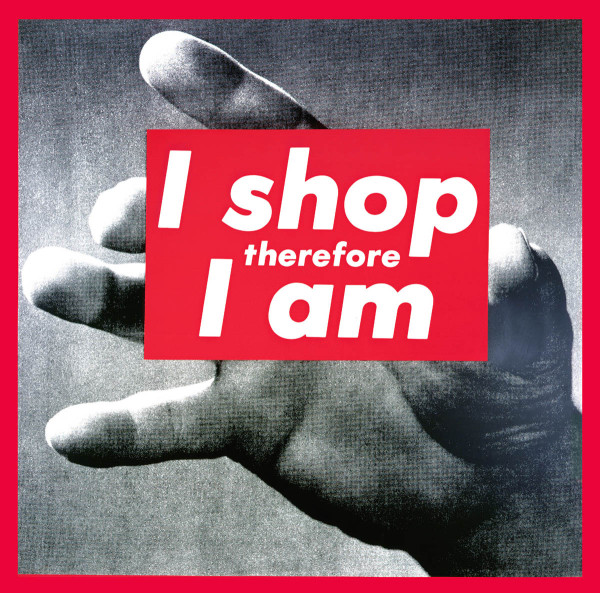
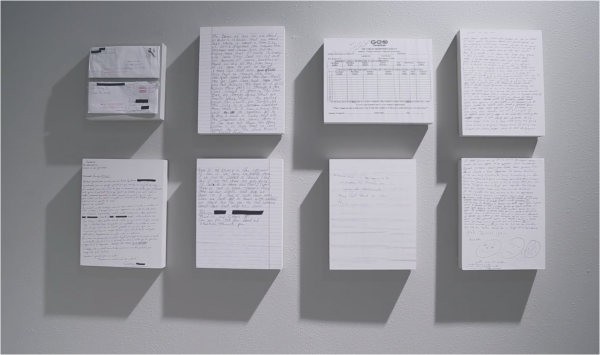

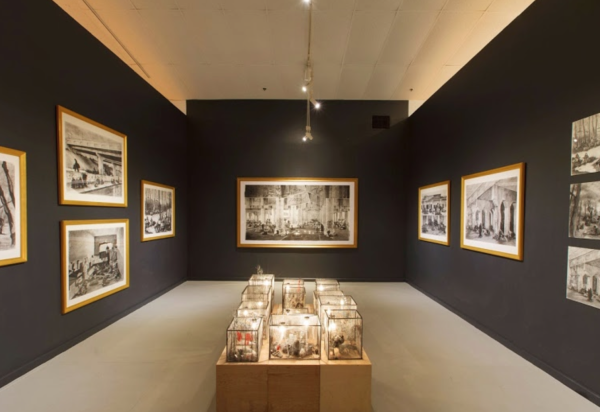
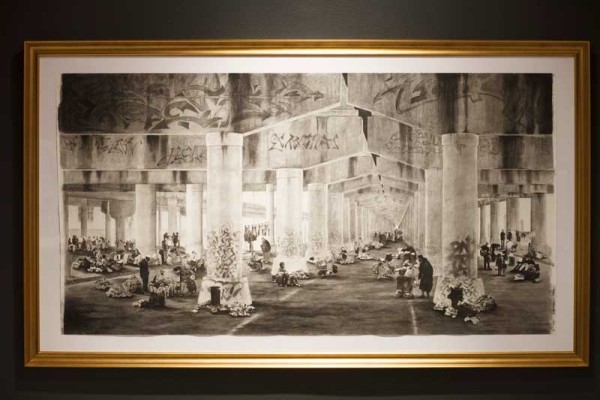
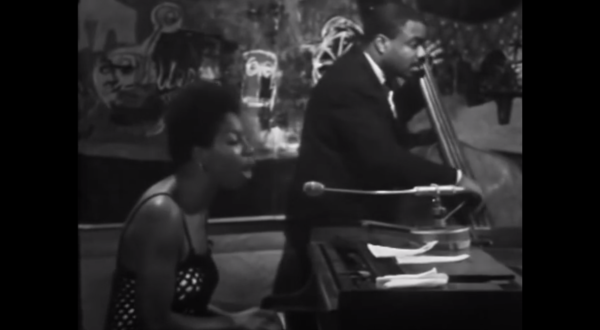
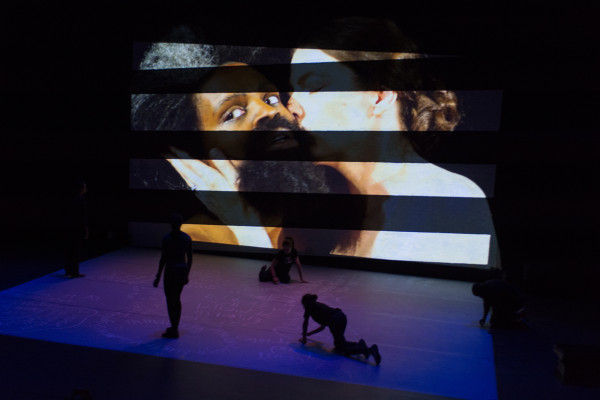
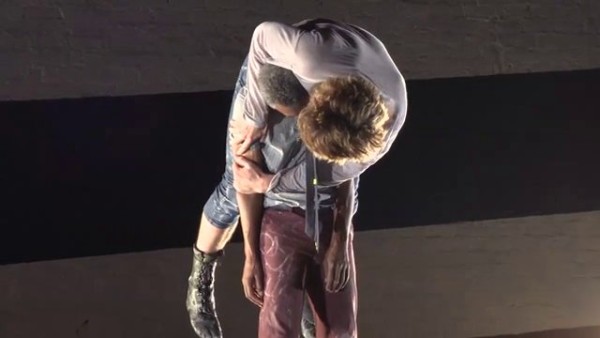


7 comments
This just came in from the great Paula Newton (who writes our news most days). It’s a clip of Nina Simone at the very foo-foo Montreaux Jazz Festival, in 1976. She was invited to come and she performed the schmaltzy piece of junk “Feelings” for the jazz snobs. Brilliant.
https://www.youtube.com/watch?v=mH5ZE3N8cxU
And this!
http://themuse.jezebel.com/the-new-nina-simone-documentary-looks-incredible-1700987355/+ellieshechet
I keep coming up a day late and a dollar short on those halcyon days (the 90’s when my kids were starting to walk and talk)of the streets being paved with gold,oh wait thats why my Grandparents left the old country for… I am so very happy that you have found Nina Simone.
I will keep reading Glasstire,’work hard,rock hard and wear glasses if you need’em’ Web Wilder
Political art is like any other art in that the weight is more in the medium and the message and the look like art than originality or quality for the most part. Same for performance or any other “labelled art.”
Not too shocked that you would cotton to a Nina Simone clip as opposed to some of the other really strong pieces in show..i.e. Gordon Park’s photos of Eldridge and Kathleen Cleaver and Charles White’s magnificent “Birmingham Totem”. Am a bit saddened that you failed to highlight the impetus for that ‘jazzy protest’ song of hers -the cowardly murder of Medgar Evers. I think that for some, political art loses its punch or ‘originality’ because they harbor an aversion to look unblinkingly at such a situation or have a hard time abstracting themselves into such a situation. At either place, somebody’s humanity is leaking out. And by the way, Montreaux is no more a foo-foo jazz festival than the ones in Newport, Seattle or New Orleans. It just happens to be in Switzerland.
Last July in “In Defense of Online Comments” you wrote that “Writing generally, and writing about art specifically, is a difficult business. Doing it well requires hours of work by multiple people. Many conversations, thinking, and a lot of wordsmithing go into a well-written article (to say nothing of a good education and a lifetime of reading and looking at art).”
It is true, writing about art is difficult, and not everyone does well at explaining themes, techniques or proper context. That said I found much to disagree with in your review, usually your writing has a clear style. It’l’ be a blog post stlyled collection of images such as in last Mays “Good Enough ISN’T: Basketball Art” or it’ll be a researched and thoughtful critique of an artist, his work, his opinions, and the circumstances that make the work interesting, or not, such as in your report on Alfredo Jaar in 2013. With this piece I can see your intention but at times it is misinformed, a response is appropriate.
Regarding Sin Huellas: Detention Nation, it seems that you took the time to read the each of the letters, and thats comforting, because in those letters lies the humanity of the people detained. Unfortunately your impression of the exhibits sculptural elements is misguided, chain link fences and mylar blankets being described as standard fare implies that there is a more exceptional reality for those who are in detention centers. Maybe a more striking visual would be to dig a twenty foot pit for museum guest to walk down into, this could represent how society buries the issue of interminable processing times for immigrants in detention. That could be striking, but it would also be conceptual, and the themes of this installation are rooted in realism. The reality of these facilities is that they are cold, somber, and boring. Some of the members of Sin Huellas have experienced this and they would likely testify that buy using theses readymade objects in a gallery space it creates a new context to engage their purpose.
Regarding Mary Jenewein: Far From Home, I agree that these collages are got damn beautiful without any supplemental commentary, but not every exhibit requires it. Think of any of the David Hammons sculptures which you’ve seen, they translate a message about an issue without additional text. This is what we usually expect from art, to focus our attention on the worlds problems. A more serious critique of her exhibit may be that the drawings make us feel bad-good, without suggesting a path towards solving the issue. Also its a journalistic cop-out to suggest that because of her age Mary cannot take any criticism, in fact unsolicited sympathy is arguably a greater insult than any critique you could possibly muster.
Regarding Witness: Art and Civil Rights in the Sixties, its wonderful that you have finally discovered Nina Simone, but as Mr. Reece mentioned above, you’re magnetism to Nina’s voice and wikipedia page led to you overlooking the context of the song, and the exhibit as a whole deserves much more attention. Its understandable why people gravitate toward black protest music, blues is easier to interpret and much more comforting to reflect on than “Daddy I Want to be Free” a photo by Ernest C. Withers, or the “Black Bathroom #2” a sculpture by Jim Dine.
( I know you cant write about every show but what you do write ought to be 1.thoughtful and 2.actually about the piece shown) Looking forward to the next piece.
Wouldn’t it be interesting to see more critiques of critiques. It’d be eternally self-reflective. Well I guess thats what the comment section is for.
Thank you for this extremely thoughtful comment. You make some very good points.
Just a few responses:
1. I stand by my assessment of the Sin Huellas installation. It is extremely moving and thought-provoking, and therefore succeeds as a piece of political activism. But it doesn’t succeed as art installation.
2. You’re right: Mary Jenewein shouldn’t get any slack just because she’s an octogenarian.
3. On Nina Simone: with all great art, the more knowledge one has, the richer one’s appreciation and understanding, and I’m glad (and sobered) to learn what specific atrocity the song is about, just as I’m glad to have learned about Nina Simone herself. But I would also respectfully argue that anybody familiar with the antebellum, Civil War, Reconstruction and Jim Crow periods in the American South can appreciate and be moved by the song “Mississippi Goddamn,” even without being aware of the song’s specific context.
4. Yes, the Jim Dine piece in “Witness” is also great. As are the documentary photographs of various Civil Rights subjects, both famous and unknown, as are other pieces in the show. (I could have done with less Robert Indiana.) But what stuck with me for weeks afterwards was Nina Simone’s unflinching virtuosity and raw anger, and that’s why I included her in this list.
Again, thanks for reading and taking the time to respond.